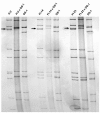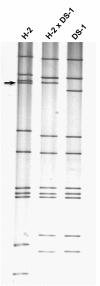Concentration of acrylamide in a polyacrylamide gel affects VP4 gene coding assignment of group A equine rotavirus strains with P[12] specificity
- PMID: 20573245
- PMCID: PMC2903560
- DOI: 10.1186/1743-422X-7-136
Concentration of acrylamide in a polyacrylamide gel affects VP4 gene coding assignment of group A equine rotavirus strains with P[12] specificity
Abstract
Background: It is universally acknowledged that genome segment 4 of group A rotavirus, the major etiologic agent of severe diarrhea in infants and neonatal farm animals, encodes outer capsid neutralization and protective antigen VP4.
Results: To determine which genome segment of three group A equine rotavirus strains (H-2, FI-14 and FI-23) with P[12] specificity encodes the VP4, we analyzed dsRNAs of strains H-2, FI-14 and FI-23 as well as their reassortants by polyacrylamide gel electrophoresis (PAGE) at varying concentrations of acrylamide. The relative position of the VP4 gene of the three equine P[12] strains varied (either genome segment 3 or 4) depending upon the concentration of acrylamide. The VP4 gene bearing P[3], P[4], P[6], P[7], P[8] or P[18] specificity did not exhibit this phenomenon when the PAGE running conditions were varied.
Conclusions: The concentration of acrylamide in a PAGE gel affected VP4 gene coding assignment of equine rotavirus strains bearing P[12] specificity.
Figures




Similar articles
-
Acrylamide concentration affects the relative position of VP7 gene of serotype G2 strains as determined by polyacrylamide gel electrophoresis.J Clin Virol. 2008 Aug;42(4):374-80. doi: 10.1016/j.jcv.2008.03.019. Epub 2008 May 23. J Clin Virol. 2008. PMID: 18457989 Free PMC article.
-
Relationship between electropherotypes and VP7/VP4 genotypes of group A rotaviruses detected between 2000 and 2007 in Tunisian children.Pathol Biol (Paris). 2011 Jun;59(3):e43-8. doi: 10.1016/j.patbio.2009.04.008. Epub 2009 May 29. Pathol Biol (Paris). 2011. PMID: 19481882
-
Preparation and characterization of a neutralizing monoclonal antibody directed to VP4 of rotavirus strain K8 which has unique VP4 neutralization epitopes.Arch Virol. 1991;121(1-4):153-62. doi: 10.1007/BF01316751. Arch Virol. 1991. PMID: 1722090
-
Species specificity and interspecies relatedness in VP4 genotypes demonstrated by VP4 sequence analysis of equine, feline, and canine rotavirus strains.Virology. 1994 May 1;200(2):390-400. doi: 10.1006/viro.1994.1203. Virology. 1994. PMID: 8178429
-
Efficient production of antigenic mosaic reassortants of rotavirus with the aid of anti-VP4 and anti-VP7 neutralizing monoclonal antibodies.J Virol Methods. 1993 Sep;44(1):25-34. doi: 10.1016/0166-0934(93)90004-b. J Virol Methods. 1993. PMID: 7693744
References
-
- Estes MK, Kapikian AZ. In: Fields virology. 5. Knipe DM, Howley PM, Griffin DE, Lamb RA, Martin MA, Roizman B, Straus SE, editor. Philadelphia, PA: Lippincott Williams and Wilkins; 2007. Rotaviruses; pp. 1917–74.
-
- Saif LJ, Rosen BI, Parwani AVL. In: Viral Infections of the Gastrointestinal Tract. Kapikian AZ, editor. New York: Marcel Dekker; 1994. Animal rotaviruses; pp. 279–367.
-
- Flewett TH, Bryden AS, Davies H. Virus diarrhoea in foals and other animals. Vet Rec. 1975;96:477. - PubMed
Publication types
MeSH terms
Substances
Grants and funding
LinkOut - more resources
Full Text Sources

